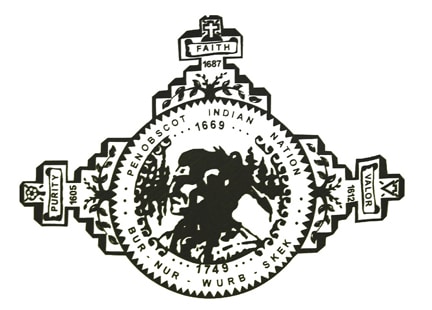The Penobscot Indian Tribe was part of the Wabanaki Confederacy along with the Abenaki, Passamaquoddy, Maliseet, and Micmac tribes. They are considered Northeastern Indian Tribe and, at the time of European contact, lived in Maine.

They were one of the few Native American tribes to side with the Patriots during the Revolutionary War and played a critical role in defending America from British attacks from Canada.
Unfortunately, their sacrifice was not remembered, and like many Native Americans, they were removed from their lands.
Jump to:
History

The Penobscot Indian Tribe, like many Northeastern Native Americans, was a hunter-gatherer tribe.
This was largely due to the climate and the resources that were around them, which included fish and game meat.
The tribe had some agriculture, but the climate allowed for a short growing season, which meant that their agriculture could not sustain their needs.
Their first contact with European explorers was through the fur trade. It was lucrative, and the Penobscot were willing to trade pelts for European goods such as metal axes, guns, and copper or iron cookware. The fur trade had an unintended but predictable side effect in that it diminished the wildlife in the area.
The fur trade also gave the Penobscot access to European alcohol and disease. Some believed that the tribe was susceptible to alcohol, but alcohol was not foreign to the tribe as they made their own form of beer that had vitamin C and protected them from scurvy.
However, the infectious disease that came from the Europeans devastated many native tribes.
The Penobscots sided with the French during the French and Indian War in the mid-18th century after the English refused to respect the Penobscots' intended neutrality.
With the Spencer Phips proclamation of 1755, the colonies put a bounty on the scalps of all Penobscots. With a smaller population and greater acceptance of intermarriage, the French posed a lesser threat to the Penobscots' land and way of life.
This alliance would leave the Penobscot in a weakened position after the French lost the Battle of Quebec and turned over their lands to the English Crown.
This would lead to the Penobscot siding with the Americans during the American Revolution. The natives were an important part of being a buffer between Canada and the United States.
Their threat caused much caution from the British, who did not have a large number of men in Canada and were prepared for more of a defensive campaign rather than an offensive one.
Their contributions to American freedom were forgotten, and unfortunately, their names were lumped in with the natives who sided with the British.
Soon, the new nation of expansionists pushed this great nation off of their land.
In the following centuries, the Penobscot attempted to make treaties in order to hold on to some form of land, but because they had no power of enforcement in Massachusetts or Maine, Americans kept encroaching on their lands.
From about 1800 onward, the Penobscot lived on reservations, specifically Indian Island, which is an island in the Penobscot River near Old Town, Maine.
The Maine state government appointed a Tribal Agent to oversee the tribe.
The tribe still exists today. The Penobscot and the state reached a settlement, the Maine Indian Claims Settlement Act, in 1980, resulting in an $81.5-million-dollar settlement that the Penobscot could use to acquire more tribal land.
The terms of the settlement provided for such acquisition, after which the federal government would hold some of this land in trust for the tribe, as is done for reservation land.
The tribe could also purchase other lands in a regular manner. The act established the Maine Indian Tribal-State Commission, whose function was to oversee the effectiveness of the Act and to intervene in certain areas, such as fishing rights, etc., in order to settle disputes between the state and the Penobscot or Passamaquoddy.
